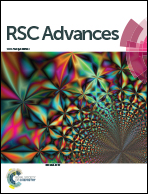Magnetic beads carrying poly(acrylic acid) brushes as “nanobody containers” for immunoaffinity purification of aflatoxin B1 from corn samples†
Abstract
The magnetic-bead-based immunoaffinity extraction (M-IAE) method has been widely used for the purification of aflatoxin B1 (AFB1) from complex food and feed matrices. However, this method suffers from several inherent disadvantages that limit its practical application, including low reusability and limited saturated adsorption capacity. Herein, we report an improved M-IAE for the highly efficient purification of AFB1 from corn samples. This method involves the expression of anti-AFB1 nanobodies (Nbs), which possess high degeneration resistance, to replace conventional antibodies; and magnetic beads carrying poly(acrylic acid) brushes (MB@PAA) were fabricated as an “Nb container” for improving AFB1 adsorption capacity. The MB@PAA shows a high loading capacity for anti-AFB1 Nbs at 623 μg g−1, which is 19-fold the magnitude of that of conventional MB@Nbs. Meanwhile, the resultant MB@PAA@Nbs exhibit good AFB1 adsorption, with a maximum adsorption capacity of 0.23 mg g−1, which is 35-fold superior to that of the conventional MB@Nbs. MB@PAA@Nbs can be reused at least 10 times, without obvious loss of the capture efficiency for AFB1. The reliability and practicability of the proposed MB@PAA@Nbs for AFB1 extraction were further evaluated using AFB1-spiked corn samples. In brief, the proposed MB@PAA@Nbs-based immunoaffinity extraction method is a highly promising, novel sample pre-treatment platform for AFB1 as well as other mycotoxins.


 Please wait while we load your content...
Please wait while we load your content...